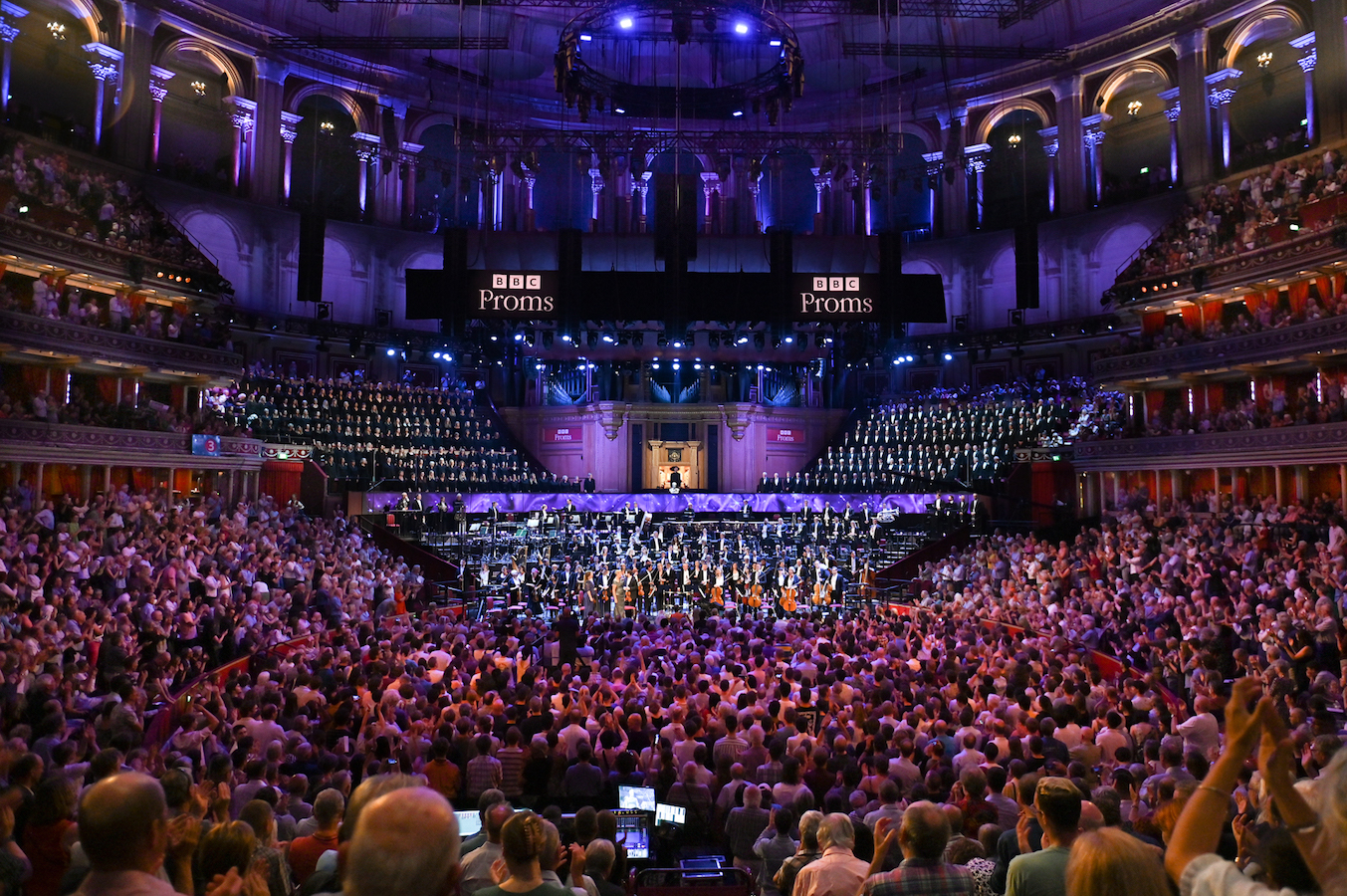Prom 49, Mahler's 'Resurrection' Symphony, Connolly, Alder, LSO, Rattle review - a long and grand goodbye | reviews, news & interviews
Prom 49, Mahler's 'Resurrection' Symphony, Connolly, Alder, LSO, Rattle review - a long and grand goodbye
Prom 49, Mahler's 'Resurrection' Symphony, Connolly, Alder, LSO, Rattle review - a long and grand goodbye
A great Mahlerian marks his signature work with a thrilling flourish

Long goodbyes don’t get grander, warmer or more passionate than this. Sir Simon Rattle began his farewell season with the London Symphony Orchestra with a Proms performance of Mahler’s Second, “Resurrection” Symphony – the mighty work that has waymarked the major moves of his career.
For the good old, bad old Royal Albert Hall had an absolutely stellar night, from the combined choirs of the LSO Chorus and CBSO chorus quietly, then loudly, storming heaven above to the artful deployment of the stage space by the soloists (Louise Alder and Dame Sarah Connolly, pictured below), the spine-tingling offstage brass and percussion, and – not least – a rapt full house that rose in a genuine standing ovation at the end. After four decades, Rattle’s Mahler – sustained and refined through his CBSO, Berlin Philharmonic and LSO phases – may have little very new to show us. Still, it remains a career-defining achievement that can yield nights, such as this, to relish and remember.  The evening’s valedictory theme began with the opener: the late Harrison Birtwistle’s Donum Simoni MMXVIII, written for the conductor in 2018. Rattle’s spoken introduction called his friend Harry “warm, gruff and funny at the same time”, and identified this brief fanfare-like piece a “tapas” of Birtwistle style. So it proved, with its pawky, mocking tuba and trombones, its clatter and clang of blocks and bells, its outraged interjections from the woodwinds and an almost cartoonish tapestry of quirkily coloured sound.
The evening’s valedictory theme began with the opener: the late Harrison Birtwistle’s Donum Simoni MMXVIII, written for the conductor in 2018. Rattle’s spoken introduction called his friend Harry “warm, gruff and funny at the same time”, and identified this brief fanfare-like piece a “tapas” of Birtwistle style. So it proved, with its pawky, mocking tuba and trombones, its clatter and clang of blocks and bells, its outraged interjections from the woodwinds and an almost cartoonish tapestry of quirkily coloured sound.
The composer had warned Rattle not “to pretty it up”, and the same injunction held for the opening parts (at least) of the Resurrection symphony. Rattle knows that Mahler's epic journey through every shade of darkness into light needs space and patience for the unfolding drama to grow. His opening funeral march felt (if anything) a little short on maestoso solemnity. Sardonic wit crackled through the movement, from the crunching, slapping lower strings to the spiky, restless woods and the grainy, punchy, snarling LSO brass – full of almost cocksure confidence, here and throughout the work. The silken, or swooping, strings sounded almost bullied by all the rasping turbulence around them, but then Rattle was playing a long game here. His huge dynamic spans, from a gentle whisper to a hall-shaking roar, felt integral rather than mannered, and his accelerandos had a real sense not just of mounting excitement but edge-of-the-cliff menace. We needed the pause that followed, to calm down and prepare for the long climb still to come. In the lilting Ländler of the andante, that sprinkle of mischief returned to dissolve any risk of schmaltz, with pizzicato strings that stuck just this side of mockery. Far from aiming for a premature monumentality, Rattle in the symphony’s first half showed off his urbane, sardonic, almost cabaret-band talents, with strings, luscious slides and all, that sounded slightly lightweight compared to the stonking swagger of his brass. However, he was holding plenty in reserve. With its gurgling, fishy woodwinds, beautifully despatched, the supposedly “calmly flowing” third-movement scherzo had plenty of underwater snags and whirlpools too. The sickened, lurching mood of the music found the LSO in superbly bilious mood, with woodwind injections full of accent and attitude and a riveting star turn for the trumpets. Here, as elsewhere, you heard the score-less Rattle’s astonishingly sure command not just of this whole cathedral of feeling but of each grimacing gargoyle or fragment of luridly stained glass.
In the lilting Ländler of the andante, that sprinkle of mischief returned to dissolve any risk of schmaltz, with pizzicato strings that stuck just this side of mockery. Far from aiming for a premature monumentality, Rattle in the symphony’s first half showed off his urbane, sardonic, almost cabaret-band talents, with strings, luscious slides and all, that sounded slightly lightweight compared to the stonking swagger of his brass. However, he was holding plenty in reserve. With its gurgling, fishy woodwinds, beautifully despatched, the supposedly “calmly flowing” third-movement scherzo had plenty of underwater snags and whirlpools too. The sickened, lurching mood of the music found the LSO in superbly bilious mood, with woodwind injections full of accent and attitude and a riveting star turn for the trumpets. Here, as elsewhere, you heard the score-less Rattle’s astonishingly sure command not just of this whole cathedral of feeling but of each grimacing gargoyle or fragment of luridly stained glass.
As so often with Mahler, the human voice will redeem us. The brass chorale gorgeously soothed our fevers, and Sarah Connolly’s sang “Urlicht” with commanding serenity, poise and strength, enhanced by the lovely contributions from LSO leader Andrej Power. We still have a long road to travel, though, and Rattle kept his most ferocious episodes back for the despairing savagery of the fifth movement. The offstage horns have never sounded more eerie; the apocalyptic drumrolls of doom stopped your breath (on a night of explosive virtuosity from the LSO timpani). But then Timothy Jones and the horns, James Fountain and the trumpets, Peter Moore and trombones – all sounded splendid, with Gareth Davies and Sarah Bennett’s flutes finely flavoursome as well. Harps (Bryn Lewis and Helen Tunstall) and, at the close, Richard Gowers' heavenly organ, signally enriched an orchestral tone that could be luxurious but never just lush. As for the strings, their increasingly mellow warmth truly glowed as Louise Alder joined Connolly for the setting of Klopstock’s poetic assurance that “thou wert not born in vain”.  First above on one side, then from front-of-stage with Connolly, Alder sang with a tender fervour that soared thrillingly above the fray. However, the finale – here as often – belonged to the chorus. Hushed and delicate at first, the CBSO and LSO rose in every sense – they stand only before their final lines – with a clarity of phrasing (and lucidity of diction) that made the closing passages humanly touching, not just collectively ecstatic. The chorus masters (Rattle’s long-standing comrade Simon Halsey, with Julian Wilkins) masterminded a sublime leave-taking, which felt not like a heavy, bullying mass declamation but a private voice of hope somehow shared by all.
First above on one side, then from front-of-stage with Connolly, Alder sang with a tender fervour that soared thrillingly above the fray. However, the finale – here as often – belonged to the chorus. Hushed and delicate at first, the CBSO and LSO rose in every sense – they stand only before their final lines – with a clarity of phrasing (and lucidity of diction) that made the closing passages humanly touching, not just collectively ecstatic. The chorus masters (Rattle’s long-standing comrade Simon Halsey, with Julian Wilkins) masterminded a sublime leave-taking, which felt not like a heavy, bullying mass declamation but a private voice of hope somehow shared by all.
If the sheer theatricality of Rattle’s step-by-step, phrase-by-phrase direction of the whole vast voyage impressed once again, so did the intimacy he can bring to even the smallest corners of the big picture. The dramatic tension, even suspense, scarcely dropped for a moment. The thunderous outbursts froze the blood; the passages of stillness and peace made it flow again. Over-exposure, to this conductor or this work, can make you wonder why either have to matter so much. Last night he gave a resounding answer.
rating
Explore topics
Share this article
Add comment
The future of Arts Journalism
You can stop theartsdesk.com closing!
We urgently need financing to survive. Our fundraising drive has thus far raised £49,000 but we need to reach £100,000 or we will be forced to close. Please contribute here: https://gofund.me/c3f6033d
And if you can forward this information to anyone who might assist, we’d be grateful.

Subscribe to theartsdesk.com
Thank you for continuing to read our work on theartsdesk.com. For unlimited access to every article in its entirety, including our archive of more than 15,000 pieces, we're asking for £5 per month or £40 per year. We feel it's a very good deal, and hope you do too.
To take a subscription now simply click here.
And if you're looking for that extra gift for a friend or family member, why not treat them to a theartsdesk.com gift subscription?
more Classical music
 Monteverdi Choir, ORR, Casado, St Martin-in-the-Fields review - flames of joy and sorrow
First-rate soloists, choir and orchestra unite in a blazing Mozart Requiem
Monteverdi Choir, ORR, Casado, St Martin-in-the-Fields review - flames of joy and sorrow
First-rate soloists, choir and orchestra unite in a blazing Mozart Requiem
 Cho, LSO, Pappano, Barbican review - finely-focused stormy weather
Chameleonic Seong-Jin Cho is a match for the fine-tuning of the LSO’s Chief Conductor
Cho, LSO, Pappano, Barbican review - finely-focused stormy weather
Chameleonic Seong-Jin Cho is a match for the fine-tuning of the LSO’s Chief Conductor
 Classical CDs: Shrouds, silhouettes and superstition
Cello concertos, choral collections and a stunning tribute to a contemporary giant
Classical CDs: Shrouds, silhouettes and superstition
Cello concertos, choral collections and a stunning tribute to a contemporary giant
 Appl, Levickis, Wigmore Hall review - fun to the fore in cabaret and show songs
A relaxed evening of light-hearted fare, with the accordion offering unusual colours
Appl, Levickis, Wigmore Hall review - fun to the fore in cabaret and show songs
A relaxed evening of light-hearted fare, with the accordion offering unusual colours
 Lammermuir Festival 2025, Part 2 review - from the soaringly sublime to the zoologically ridiculous
Bigger than ever, and the quality remains astonishingly high
Lammermuir Festival 2025, Part 2 review - from the soaringly sublime to the zoologically ridiculous
Bigger than ever, and the quality remains astonishingly high
 BBC Proms: Ehnes, Sinfonia of London, Wilson review - aspects of love
Sensuous Ravel, and bittersweet Bernstein, on an amorous evening
BBC Proms: Ehnes, Sinfonia of London, Wilson review - aspects of love
Sensuous Ravel, and bittersweet Bernstein, on an amorous evening
 Presteigne Festival 2025 review - new music is centre stage in the Welsh Marches
Music by 30 living composers, with Eleanor Alberga topping the bill
Presteigne Festival 2025 review - new music is centre stage in the Welsh Marches
Music by 30 living composers, with Eleanor Alberga topping the bill
 Lammermuir Festival 2025 review - music with soul from the heart of East Lothian
Baroque splendour, and chamber-ensemble drama, amid history-haunted lands
Lammermuir Festival 2025 review - music with soul from the heart of East Lothian
Baroque splendour, and chamber-ensemble drama, amid history-haunted lands
 BBC Proms: Steinbacher, RPO, Petrenko / Sternath, BBCSO, Oramo review - double-bill mixed bag
Young pianist shines in Grieg but Bliss’s portentous cantata disappoints
BBC Proms: Steinbacher, RPO, Petrenko / Sternath, BBCSO, Oramo review - double-bill mixed bag
Young pianist shines in Grieg but Bliss’s portentous cantata disappoints
 theartsdesk at the Lahti Sibelius Festival - early epics by the Finnish master in context
Finnish heroes meet their Austro-German counterparts in breathtaking interpretations
theartsdesk at the Lahti Sibelius Festival - early epics by the Finnish master in context
Finnish heroes meet their Austro-German counterparts in breathtaking interpretations
 Classical CDs: Sleigh rides, pancakes and cigars
Two big boxes, plus new music for brass and a pair of clarinet concertos
Classical CDs: Sleigh rides, pancakes and cigars
Two big boxes, plus new music for brass and a pair of clarinet concertos
 Waley-Cohen, Manchester Camerata, Pether, Whitworth Art Gallery, Manchester review - premiere of no ordinary violin concerto
Images of maternal care inspired by Hepworth and played in a gallery setting
Waley-Cohen, Manchester Camerata, Pether, Whitworth Art Gallery, Manchester review - premiere of no ordinary violin concerto
Images of maternal care inspired by Hepworth and played in a gallery setting

Comments
It was astonishing, a truly
Just one quibble (from a CBSO
It was simply superb!
It felt a privilege to be
but for all its mighty forces